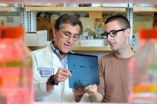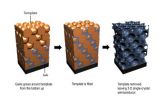(Press-News.org) A new target for nitric oxide has been revealed in studies of how it inhibits the growth of Salmonella. This bacterium is a common cause of food-poisoning.
"Nitric oxide is naturally produced in the nose and the gut and other tissues in the body to ward off infection," explained the senior author of the paper, Dr. Ferric Fang. He is a University of Washington (UW) professor of laboratory medicine, microbiology and medicine.
Nitric oxide – not to be confused with nitrous oxide, the laughing gas in dentists' offices – is similar to the preservatives in hotdogs, Fang said. Reactive nitrogen species, like nitric oxide, make brown meat an appetizing pink. They also weed out microorganisms that spoil food or cause food poisoning.
Fang's lab has made several important discoveries on ways mammals exploit the biochemical properties of nitric oxide to defend themselves from germs. Nitric oxide, a key actor in the body's innate immune defenses, apprehends a rogue's gallery of disease-causing organisms.
The newest results underscore that nitric oxide's antimicrobial actions are due to its interference with the metabolism, or energy production, of pathogens.
"Nitric oxide imposes substantial metabolic restrictions on bacteria," the researchers noted. Fang explained that its reactions with numerous metabolic targets accounts for the broad-spectrum nature of its success. It keeps many types of disease-causing bacteria at bay. It also prevents an overgrowth of the body's many helpful bacteria.
The latest report on the versatility of nitric oxide in arming hosts against pathogens is published in the July 21 issue of Cell Host & Microbe. Dr. Anthony R. Richardson, who is now at the University of North Carolina at Chapel Hill, led the research while he was a postdoctoral fellow in the Fang lab.
Fang's team looked at the multi-pronged action of nitric oxide on Salmonella enterica serovar Typhimurium. This type of Salmonella can contaminate food and is similar to the bacteria that cause typhoid fever.
Nitric oxide and related chemicals put Salmonella into a difficult situation called nitrosative stress. When exposed to nitric oxide, Salmonella is unable to make two essential amino acids, methionine and lysine.
Without these, Salmonella cannot grow.
"This is bad news for the bacteria, but not for the host," Fang said. "Nitric oxide doesn't damage the host that produces it."
The ability to withstand nitrosative stress makes some forms of bacteria more virulent than milder types that can't handle it.
Richardson and his colleagues found that nitric oxide and its cousins throw a monkey wrench into several points in the Krebs cycle, also known as the tricarboxylic acid cycle. This cycle is the second stage in cellular respiration, when fuel is broken down to release energy for cell growth and division.
The researchers outlined how multiple interruptions in this cycle create a series of biochemical consequences that starve Salmonella of methionine and lysine. Nitric oxide also blocks certain regulatory genes that otherwise would give Salmonella an alternate chemical route out of its distress.
"Collectively, this work demonstrates that nitric oxide imposes substantial metabolic restrictions on bacteria," the authors concluded.
In a commentary on these findings, Dr. Stephen Spiro of the Department of Molecular and Cell Biology at the University of Texas at Dallas wrote that the work "focuses renewed interest in central metabolic pathways as nitric oxide targets."
"More generally," he noted, "this study provides an excellent illustration that a proper understanding of host-pathogen interactions and the development of therapeutic interventions require a detailed knowledge of pathogen metabolism."
Nitric oxide's targeting of the Krebs cycle is not unique to Salmonella. In learning how the body naturally controls the energy supplies and growth of varied disease-causing organisms, Fang said, scientists may be able to develop new broad-spectrum antimicrobials that mimic these effects, drugs that promote the body's own natural defenses against infection, or agents that overcome the ways virulent bacteria compensate when being starved of certain nutrients.
INFORMATION:
In addition to Richardson and Fang, the UW researchers on the study "Multiple Targets of Nitric Oxide of the Tricarboxylic Acid (TCA) Cycle of Salmonella enterica Serovar Typhimurium" were Elizabeth C. Payne, Noah Younger, Joyce E. Karlinsey, Vinai Thomas, Lynne Becker, William W. Navarre, Margaret E. Castor and Stephen J. Libby.
The research was supported by grants from the National Institutes of Health.
New target found for nitric oxide's attack on salmonella bacteria
Naturally produced by the body, nitric oxide disrupts pathogens' metabolism
2011-07-25
ELSE PRESS RELEASES FROM THIS DATE:
2 genetic variations predict second cancers after radiation for children with Hodgkin lymphoma
2011-07-25
A genome-wide association study published in the August issue of Nature Medicine has found two tiny genetic variations that can predict which patients with Hodgkin's lymphoma are most likely to develop radiation-induced second cancers years after treatment. Knowing in advance who is at risk could help physicians tailor treatment to reduce the risks for patients who are most susceptible to long-term damage.
Hodgkin's lymphoma is one of the most treatable cancers, with more than 90 percent of patients surviving after a combination of radiation and chemotherapy. But nearly ...
Graphene's 'quantum leap' takes electronics a step closer
2011-07-25
Writing in the journal Nature Physics, the academics, who discovered the world's thinnest material at The University of Manchester in 2004, have revealed more about its electronic properties.
Research institutes and universities around the world are already looking at ways to build devices such as touch-screens, ultrafast transistors and photodetectors.
Now the research from the creators of the material promises to accelerate that research, and potentially open up countless more electronic opportunities.
The researchers, from the universities of Manchester, Madrid ...
Pocket chemistry: DNA helps glucose meters measure more than sugar
2011-07-25
CHAMPAIGN, Ill. — Glucose meters aren't just for diabetics anymore. Thanks to University of Illinois chemists, they can be used as simple, portable, inexpensive meters for a number of target molecules in blood, serum, water or food.
Chemistry professor Yi Lu and postdoctoral researcher Yu Xiang published their findings in the journal Nature Chemistry.
"The advantages of our method are high portability, low cost, wide availability and quantitative detection of a broad range of targets in medical diagnostics and environmental monitoring," Lu said. "Anyone could use it ...
New photonic crystals have both electronic and optical properties
2011-07-25
CHAMPAIGN, Ill. — In an advance that could open new avenues for solar cells, lasers, metamaterials and more, researchers at the University of Illinois have demonstrated the first optoelectronically active 3-D photonic crystal.
"We've discovered a way to change the three-dimensional structure of a well-established semiconductor material to enable new optical properties while maintaining its very attractive electrical properties," said Paul Braun, a professor of materials science and engineering and of chemistry who led the research effort.
The team published its advance ...
Epigenetic 'memory' key to nature versus nurture
2011-07-25
Researchers funded by the Biotechnology and Biological Sciences Research Council (BBSRC) at the John Innes Centre have made a discovery, reported this evening (24 July) in Nature, that explains how an organism can create a biological memory of some variable condition, such as quality of nutrition or temperature. The discovery explains the mechanism of this memory – a sort of biological switch – and how it can also be inherited by offspring.
The work was led by Professor Martin Howard and Professor Caroline Dean at the John Innes Centre, which receives strategic funding ...
Soft spheres settle in somewhat surprising structure
2011-07-25
Latex paints and drug suspensions such as insulin or amoxicillin that do not need to be shaken or stirred may be possible thanks to a new understanding of how particles separate in liquids, according to Penn State chemical engineers, who have developed a method for predicting the way colloidal components separate based on energy.
"The ongoing assumption was that if you have a mixture of different sized particles in a liquid, the faster-settling particles will end up on the bottom," said Darrell Velegol, professor of chemical engineering. "We found that in many cases it ...
Mismatch between cancer genetics counseling and testing guidelines and physician practices
2011-07-25
A new analysis has found that many doctors report that they do not appropriately offer breast and ovarian cancer counseling and testing services to their female patients. Published early online in CANCER, a peer-reviewed journal of the American Cancer Society, the study indicates that efforts are needed to encourage these services for high-risk women and discourage them for average-risk women.
Women with mutations in the BRCA1 or BRCA2 gene have a substantially increased risk of developing breast and ovarian cancer, but there are medical treatments that can dramatically ...
Children eating more, and more frequently outside the home
2011-07-25
Philadelphia, PA, July 25, 2011 – As childhood obesity rises and the American diet shifts towards increasing consumption of foods eaten or prepared outside of the home, concerns about the nutritional quality and the total consumption of such foods are also increasing. According to a study conducted at the University of North Carolina at Chapel Hill and published in the August 2011 issue of the Journal of the American Dietetic Association, eating location and food source significantly impact daily energy intake for children. Foods prepared away from home, including fast ...
Catching the West Nile virus in action
2011-07-25
Tel Aviv — Since 1999, several outbreaks of West Nile Virus, which causes fever or severe neurological symptoms and is transmitted from birds to humans by blood-sucking mosquitoes, have been seen in the U.S., usually during the summer months. But researchers aren't certain how the virus migrated here — and they don't know how, or where, it will appear next.
Now Prof. Ella Mendelson of Tel Aviv University's School of Public Health at the Sackler Faculty of Medicine, working with the Israeli Ministries of Health and Environment, has instituted a study that tracks both clinical ...
Double jeopardy: Tuna and billfish
2011-07-25
MIAMI – July 25, 2011 – A new study by top global fisheries experts presents an alarming assessment of several economically important fish populations. The analysis of 61 species of "scombrids," which include tunas, bonitos, mackerels and Spanish mackerels, and billfishes, which include swordfish and marlins, classified seven as threatened with extinction and four as "near threatened" for the IUCN Red List of Threatened Species.
University of Miami Rosenstiel School of Marine & Atmospheric Science associate professor, and assistant director of NOAA's Cooperative Institute ...
LAST 30 PRESS RELEASES:
If you're over 60 and playing with sex toys, you're not alone
Fame itself may be critical factor in shortening singers’ lives
Daily coffee drinking may slow biological ageing of people with major mental illness
New highly efficient material turns motion into power – without toxic lead
The DEVILS in the details: New research reveals how the cosmic landscape impacts the galaxy lifecycle
After nearly 100 years, scientists may have detected dark matter
Gender imbalance hinders equitable environmental governance, say UN scientists
Six University of Tennessee faculty among world’s most highly cited researchers
A type of immune cell could hold a key to preventing scar tissue buildup in wounds
Mountains as water towers: New research highlights warming differences between high and low elevations
University of Tennessee secures $1 million NSF grant to build semiconductor workforce pipeline
Biochar shows powerful potential to build cleaner and more sustainable cities worldwide
UT Health San Antonio leads $4 million study on glucagon hormone’s role in diabetes, obesity
65-year-old framework challenged by modern research
AI tool helps visually impaired users ‘feel’ where objects are in real time
Collaborating minds think alike, processing information in similar ways in a shared task
Routine first trimester ultrasounds lead to earlier detection of fetal anomalies
Royal recognition for university’s dementia work
It’s a bird, it’s a drone, it’s both: AI tech monitors turkey behavior
Bormioli Luigi renews LionGlass deal with Penn State after successful trial run
Are developers prepared to control super-intelligent AI?
A step toward practical photonic quantum neural networks
Study identifies target for disease hyper progression after immunotherapy in kidney cancer
Concordia researchers identify key marker linking coronary artery disease to cognitive decline
HER2-targeted therapy shows promising results in rare bile duct cancers
Metabolic roots of memory loss
Clinical outcomes and in-hospital mortality rate following heart valve replacements at a tertiary-care hospital
Too sick to socialize: How the brain and immune system promote staying in bed
Seal milk more refined than breast milk
Veterans with cardiometabolic conditions face significant risk of dying during extreme heat events
[Press-News.org] New target found for nitric oxide's attack on salmonella bacteriaNaturally produced by the body, nitric oxide disrupts pathogens' metabolism





